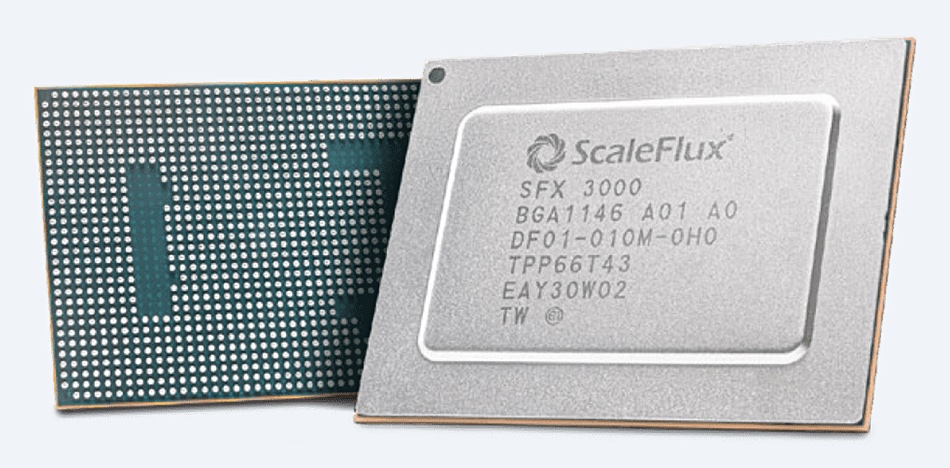ScaleFlux builds computational storage drives (CSDs) that can be used without host system software changes to speed server host data processing, unveiling a suite of new products earlier this month.
Existing CSDs with, for example, onboard Arm CPUs need host software to to tell them what to do and have on-drive software to process data on the drive. ScaleFlux has developed a line of plug-in CSDs which compress and decompress data transparently to the host system and provide SSDs which perform faster, last longer and can have greater effective capacity than standard SSDs. The compression reduces write amplification which, in turn, extends an SSD’s endurance, doubling or more the rated TB written number.
ScaleFlux senior director of Marketing Brendan Wolfe told an IT Press Tour audience: “The development of software apps to use Arm CPUs in computational storage products needs standards and they are slow to develop. The security aspect needs working out as well, lengthening standards development.”
The company developed on-drive compression system-on-chip hardware and firmware to offload the host CPU. This, together with encryption, is of general appeal, whereas other computational storage drive applications, say perhaps video transcoding, may not be of general appeal. It made the product easier to use since there need be no application integration effort.
ScaleFlux was founded in 2014 by CEO Hao Zhong and chief scientist Tong Zhang. Manufacturing is carried out in China as is some development. ScaleFlux has some 200 employees and has raised more than $60 million in funding from investors such as Kioxia, Micron and Xylinx (now AMD).

It has built up an impressive roster of customers including Alibaba, DreamWorks, Nvidia, Playtica, Tencent and T-Mobile.
The company’s SFX 3000 storage processor SoC provides compression, using a 4K window, and variable length mapping compaction. It does not do deduplication. The hardware features a PCIe gen 4 x4 or x8 host interface with a 16-channel NAND interface and two quads of ARM A53 cores.

The SoC is used to build two products: the shipping CSD (Computational Storage Drive) 3000 and the soon-to-be-shipping and capacity-multiplying NSD 3000 NVMe SSD, both using TLC (3bits/cell) flash.
The CSD 3000, compared to other NVMe SSDs with similar capacity and PCIe interface, provides 2x or more their endurance and performance as well as potentially quadrupling their capacity. The drive’s base capacity gets extended logically e.g. format a 4TB drive to 8TB. Wolfe said it’s a form of thin provisioning. Customers need to manage the extended capacity and it may require predictable data compressability as the drive fills.
The NSD 3000 will be a CSD 3000, minus the capacity multiplier, delivering >2x performance and endurance vs other 1 drive write per day SSDs with similar raw capacity.
ScaleFlux claims its products can provide up to 8x more endurance over other enterprise TLC SSDs from suppliers such as Kioxia, Samsung, Sk hynix/Solidigm and Micron. It prices its products with a 20 percent premium over standard TLC drives and says the database market is a good one for its products.

Customers using ScaleFlux SSDs provided supportive quotes. Alibaba said the CSD drives reduced its storage costs by more than 30 percent and increased performance up to 10x. A financial sector customer using Redis said storage costs went down by more than 60 percent and drive endurance was up to five times longer.
Although not required, application integration can extend these benefits with, for example, a 10x reduction in B-tree write amplification (B-trees are a type of disk data search algorithm used to speed disk data searches). Alibaba found that, with data preparation, there was 70 percent less network traffic on its PolarDB.
Wolfe said Scale Computing is shipping some edge HCI systems with ScaleFlux drives, but not the smaller NUC-based boxes because the U.2 format CSD drive doesn’t fit in their enclosure. ScaleFlux is developing an E1.s format product to solve this kind of problem. He mentioned a quote from Scale Field CTO Alan Conboy: “ScaleFlux CSDs bring a force multiplier for edge computing.”
Wolfe also said a PCIe gen 5-supporting product was in development. We might imagine a future SFX 4000 SoC and CSD 4000/NSD 4000 product line could support PCIe 5.
HPE and Aerospike are ScaleFlux integration partners:

Aerospike found that ScaleFlux drives enabled a server node to double the transactions/sec rate, exhibit more predictable latencies and multiply endurance by 4x.
ScaleFlux appears to have opened the computational storage market door where others have failed. It has done this by building better compression technology that can run on the drive and improve its performance and longevity, make latency more consistent and increase a drive’s capacity. The company’s inclusion in the 2022 Deloitte Technology Fast 500 listing, where it has a number 468 position with 265 percent revenue growth from 2018 to 2021, suggests that it is getting good traction in the market.
This, together with its general applicability, suggests to us that an SSD manufacturer could perceive that buying ScaleFlux could give it an edge over its competitors.








